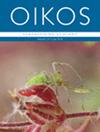热带干旱森林生态演替的多样性模式:多分类方法
IF 3.1
2区 环境科学与生态学
Q2 ECOLOGY
引用次数: 0
摘要
评估多个类群的多样性对于了解群落的组合以及评估热带次生林的完整性和功能性至关重要。在这项研究中,我们利用树木和五类昆虫(食草动物、食果蝴蝶、蚂蚁、秆蚊和蜣螂)的希尔-辛普森多样性、丰度和β-多样性分析了巴西三个地区热带干燥林(TDFs)的自然再生情况。采样工作在 39 个 0.1 公顷的地块上进行,采用了时序法(13 个地块分别位于早生林、中生林和老龄林中)。我们评估了三个不同层次对γ多样性的贡献:α(地块内)、β1(地块间)和β2(演替阶段间),并进一步确定了更替(物种更替)和嵌套(不同地点间物种数量的差异)对β2的相对重要性。我们的结果表明,出乎意料的是,在所有地区,早期生长阶段的希尔-辛普森多样性一直高于老龄生长阶段,但在中期阶段的差异更大。就每组生物而言,蝴蝶、蚂蚁、蜣螂和食草动物都有相同的趋势,蚊子在不同阶段没有差异。只有树木(沿梯度递增)和蚊子(递减)的丰度存在演替差异。根据我们的预期,加性分区分析表明,当所有类群一起考虑时,β2 多样性对γ 多样性的贡献大于β1 多样性对大多数类群的贡献(蝴蝶和蜣螂除外)。大部分的 β2 多样性是由于物种更替造成的,但这一贡献在不同类群和地区有所不同,其中食草动物的更替率最高,而蜣螂的更替率最低。我们的研究结果表明,与原始物种丰富度相比,希尔-辛普森多样性和物种组成的变化(由β2-多样性表示)是森林自然再生的更好指标,这与之前对植物和动物的研究结果相吻合。本文章由计算机程序翻译,如有差异,请以英文原文为准。
Diversity patterns along ecological succession in tropical dry forests: a multi-taxonomic approach
Evaluating the diversity of multiple taxa is fundamental to understand community assembly and to assess the integrity and functionality of tropical secondary forests. In this study, we analyzed the natural regeneration of tropical dry forests (TDFs) in three regions of Brazil using Hill–Simpson diversity, abundance and β-diversity of trees and five groups of insects (herbivores, fruit-feeding butterflies, ants, culicid mosquitoes and dung beetles). Sampling was conducted in 39 0.1 ha plots using a chronosequence approach (13 plots in early, intermediate and old-growth forests). We evaluated the contribution of three different levels to γ-diversity: α (within plots), β1 (among plots) and β2 (among successional stages), and further determined the relative importance of turnover (species replacement) and nestedness (differences in species number among sites) to β2. Our results showed that, unexpectedly, the Hill–Simpson diversity was consistently higher in early than old-growth stages for all regions, but varied more widely in the intermediate stages. For each group separately, the same trend was observed for butterflies, ants, dung beetles and herbivores and did not differ among stages for mosquitoes. Successional differences in abundance were only detected for trees (increasing along the gradient) and for mosquitoes (decreasing). According to our expectations, the additive partitioning analysis showed that β2-diversity contributed more to γ-diversity than β1-diversity, when all taxa were considered together and for most of them separately (except for butterflies and dung beetles). Most of the β2-diversity was due to species turnover, but this contribution varied among groups and regions, with the highest turnover for herbivores and the lowest for dung beetles. Our results suggest that the Hill–Simpson diversity and changes in species composition (as given by β2-diversity) are better indicators of forest natural regeneration than raw species richness, corroborating previous studies with plants and animals.
求助全文
通过发布文献求助,成功后即可免费获取论文全文。
去求助
来源期刊

Oikos
环境科学-生态学
CiteScore
6.20
自引率
5.90%
发文量
152
审稿时长
6-12 weeks
期刊介绍:
Oikos publishes original and innovative research on all aspects of ecology, defined as organism-environment interactions at various spatiotemporal scales, so including macroecology and evolutionary ecology. Emphasis is on theoretical and empirical work aimed at generalization and synthesis across taxa, systems and ecological disciplines. Papers can contribute to new developments in ecology by reporting novel theory or critical empirical results, and "synthesis" can include developing new theory, tests of general hypotheses, or bringing together established or emerging areas of ecology. Confirming or extending the established literature, by for example showing results that are novel for a new taxon, or purely applied research, is given low priority.
 求助内容:
求助内容: 应助结果提醒方式:
应助结果提醒方式:


